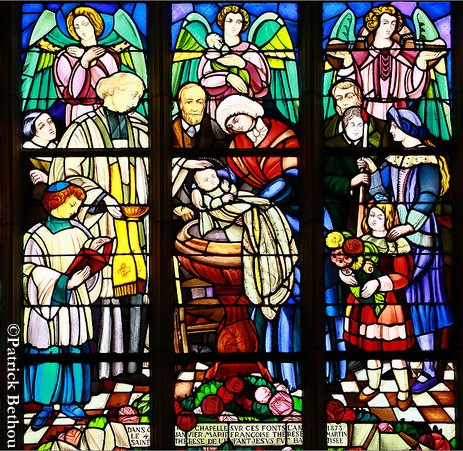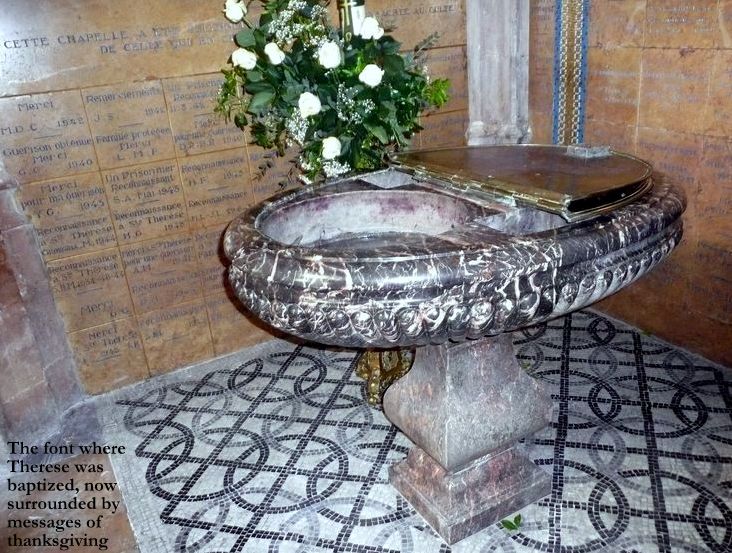The story of St. Therese's baptism on January 4, 1873

The baby Therese Martin, not yet two days old, was baptized at the Church of Our Lady of the Assumption [raised to the rank of a minor basilica after her parents were beatified in 2008] on the evening of Saturday, January 4, 1873.
Therese had been born at 11:30 at night on Thursday, January 2 in her parents’ house on rue Saint-Blaise in Alencon. This was the girlhood home of her mother, Zelie, but Louis and Zelie had moved into the house only in 1871. Thus, all eight of their older children had been baptized in the parish of St. Pierre de Montsort, where the Martins had lived for most of their marriage. Only Therese was baptized at “Notre Dame,” happily also the church in which Sts. Louis and Zelie had been married in 1858.
Fr. Lucien-Victor Dumaine, who baptized St. Therese
A medal depicting Fr. DumaineFr. Lucien-Victor Dumaine, then a vicar of Notre-Dame Church and a close friend of Therese’s father, Louis, baptized Therese. Later, he became vicar-general of the diocese of Seez (the bishop’s no. 2 man, the same role Fr. Reverony held later in the diocese of Bayeux and Lisieux when Therese wanted to enter Carmel). He testified at Therese’s diocesan process in 1910 and at her Apostolic Process in 1915. Thanks to the Web site of the Archives of the Carmel of Lisieux, from which the information about Fr. Dumaine is drawn and which I gratefully acknowledge, you may read Fr. Dumaine’s 1910 testimony about the Martin family here and his 1915 testimony about St. Therese's family here. As Fr. Dumaine was vicar of Notre Dame from 1868 to 1876, he knew the Martins well and was one of the few witnesses at the Process who could testify to the family’s life in Alencon. Because he later became vicar-general pf the diocese, he was also able to testify to Therese’s reputation for sanctity in the diocese of Seez, where she was born.
In 1910 Fr. Dumaine testified that he knew Therese’s family “intimately” and that he “knew . . . Marie, Pauline, Leonie, and Celine very well.” He had presided at the funeral of one of Therese’s little brothers. (Since this funeral took place at the parish of St. Pierre de Montsort, he was probably asked to preside because of his close friendship with St. Louis Martin). He added that he “heard the confessions of several members of the family.” This point is corroborated by a letter Zelie’s sister Marie-Louise, Sister Marie-Dosithee at the Monastery of the Visitation at Le Mans, wrote to her niece, Therese’s eldest sister Marie, then 16, on February 16, 1876:
Let us now come to piety. I am pleased that you appreciate the grace of having been brought up in the Visitation convent, yet you understand however that it will only do you as much good as the use you make of it; what use is it to have been brought up in the Visitation convent if you only have moderate piety and yet that’s what this is; you are moderately devout. I understand that M. Dumaine finds it difficult to allow you to take communion twice a month, you’re not pious enough. If you were more pious, he would certainly allow you daily communion if you had the required disposition.
You may read this letter from Sister Marie-Dosithee to Marie Martin on the Web site of the Archives of the Carmel of Lisieux.
In 1915, testifying about Therese’s reputation for sanctity in the diocese of Seez, M. Dumaine stated that “Several people have recommended themselves to my prayers for the very reason that I baptised the Servant of God myself.” He himself was devoted to Therese, prayed to her every day, and ardently wanted her cause to succeed.
Therese did not forget Fr. Dumaine. On July 23-24, 1912, speaking of Pope St. Pius X, Celine (Sister Genevieve) wrote to Leonie (Sister Francoise-Therese):
The Holy Father has just sent Fr Dumaine, who baptised Thérèse, a photo of our little sister that a prelate gave him, with a blessing written on the back. There’s nothing extraordinary about this, but what is touching is that the Holy Father withdrew to pray to Thérèse for a few minutes before writing it, asking her to heal the priest who had baptised her.1
The Pope prayed to Therese and inscribed the photo on July 8, 1912. Fr. Dumaine was then suffering terribly from stomach cancer. He survived until 1926, so he was still on earth when the little blonde baby he had baptized on that Saturday evening was canonized in 1925.
The baptismal ceremony

The baptistry of Notre Dame is located in an open “side-chapel” to the left as one enters the church. The baptismal font in which Therese was baptized is there today. St. Louis, of course, was present, but it seems that St. Zelie was not yet recovered enough to come. Therese was carried into the church by none other than Louise Marais, the maid who tormented Leonie. All Therese’s sisters were present. Her eldest sister, Marie, then almost 13, was her godmother. Therese's godfather was Paul-Albert Boul, a young man about Marie’s age who was the son of a friend of Louis Martin’s. Because this young man had been away on Friday, Therese’s baptism was postponed till Saturday evening, a delay which caused Zelie anxiety.
Later, an elaborate stained-glass window depicting Therese’s baptism was installed in the baptistry. To the right of the font depicted in the window the young godfather and his father stand near Marie, the godparents holding the baptismal candle; little Celine is near Marie. At the far left one glimpses the dark-haired Pauline. Although both M. Dumaine and Leonie testified that Leonie was present, and she signed the baptismal certificate along with the others, I can find no trace of the blonde Leonie, or of any fourth sister, in the window.
An altar and a statue of St. Therese were also added to the baptistry, with a plaque marking the saint's baptism.
The christening robe
A substantial portion of Therese’s christening robe is displayed above the font. But Therese was not the first to wear it: it had been given to Leonie by her generous godmother, Leonie Gilbert, later Mme. Jacques Tifenne. For the full story of the robe, please see my article “What is the mystery of Leonie Martin’s christening robe?”
Celine wrote two letters about the gift of this christening robe. On March 31, 1929 she wrote to Leonie:
Did you know that we’ve promised to give Notre-Dame church half of Thérèse’s baptism robe, on the condition that the awful stained-glass window in the baptistery is changed? Mgr Pasquet and the archpriest of N.-D. have reluctantly accepted our generous sacrifice. – I have therefore already divided up the robe. We’ll give the most beautiful half to Alençon, that is to say, the front of the dress with the pretty little bodice, and we’re keeping the back of the dress and little cloak.2
I do not know whether any changes were, in fact, made to the stained-glass window in the baptistry, but it seems that the first window installed incurred the Carmelites’ displeasure.
On January 24, 1934 Celine wrote to Leonie again, seeming to say that she was now going to give the back of the dress, not the front:
I’ve offered half of Thérèse’s baptism robe (the back of the skirt only), displayed in a pretty case, to the Baptistery in Alençon. It will be her gift to his Lordship, the Bishop of Séez, for [the Jubilee] on 8th May. We’re already preparing for it; it’s not too early.3
[The reference is to Octave-Louis Pasquet, appointed bishop of Seez in 1926. This Jubilee could have been the 50th anniversary of Therese’s First Communion, celebrated on May 8, 1934].
Therese's baptismal names
Therese was baptized Marie-Francoise-Therese. All the Martin daughters had the first name Marie; Francoise was to honor St. Francis de Sales, who greatly influenced the Order of the Visitation, which Zelie’s sister had joined; and, when she was expecting Therese, Zelie wrote “This child, like my last one [the little Marie-Melanie-Therese, who died at seven weeks] will be named Therese.”
Although Therese's name in religion was "Therese of the Child Jesus of the Holy Face," she remembered her baptismal names and used them on solemn occasions, for example, when she signed her "Offering of Myself as a Victim of Holocaust to Merciful Love" and her "Consecration to the Holy Face."4
Conclusion
In 2008, when I made my first visit to Notre Dame in Alencon, where a Pontifical Mass was celebrated the day before the beatification of Louis and Zelie, I prayed at the font in which Therese was baptized and had a deep sense of how much life-giving grace God has poured out on the Church and the world through Therese. I hope that many of the pilgrims who visit Notre Dame will renew their baptismal vows and, if they come as a family, invite their children to renew their own vows.
January 4, 2023 will be the 150th anniversary of the administration of this great sacrament to the "Doctor of the Science of Love," as Pope St. John Paul II called St. Therese. May we each live out the call to holiness we have received in baptism, and may our society reflect our corporate response to the universal call to holiness.
Notes
1 Letter from Sister Marie Dosithee to Marie Martin, February 6, 1876 on the Web site of the Archives of the Carmel of Lisieux (accessed January 4, 2022).
2 Letter from Celine (Sister Genevieve) to Leonie (Sister Francoise-Therese), March 31, 1929 on the Web site of the Archives of the Carmel of Lisieux (accessed January 4, 2022).
3 Letter from Celine (Sister Genevieve) to Leonie (Sister Francoise-Therese), January 24, 1934 on the Web site of the Archives of the Carmel of Lisieux (accessed January 4, 2022).
4 The Prayers of Saint Therese of Lisieux, tr. Aletheia Kane, O.C.D. Washington, D.C.: ICS Publications, 1997, pp. 53-74 ("Offering of myself as a victim of Holocaust to Merciful Love") and pp. 91-98 ("Act of Consecration to the Holy Face"). In footnote 2 to the latter, the editor notes that Therese used the initials of her own baptismal name and of the other two nuns who made this Consecration, saying "[Listing the baptismal names] is customary for the taking of vows and their annual renewal. Using it here confers on the Consecration a solemn character, which engages each sister's whole Christian being." (p. 95).
All rights to this article and its illustrations are reserved. To reproduce it, please apply for written permission.
Reader Comments